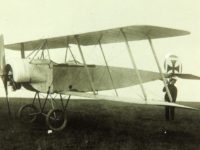The Fokker B.I and B.II aircraft were training and reconnaissance aircraft used in both the German Air Force and the Air Force of Austria-Hungary during the First World War.
Development and construction:
In mid-June 1914, the designer Anton Fokker began building two-seater high-wing aircraft as prototypes. These aircraft were intended for the German Navy.
Under the factory designation M.7 first a One and a half Decker was developed, which was equipped with a 80PS Oberursel U.0 circulating engine and should serve as a two-seated, unarmed reconnaissance aircraft.
Due to the war, however, first the monoplanes were preferred in production and the first flight of M.7 could take place only in January 1915. Since the flights were broken due to manufacturing defects, the structure had to be reinforced, which affected the flight characteristics. Of these aircraft classed as B.I type, 3 went to the German army and 7 to the German navy.
15 pieces of the aircraft were also delivered to the Air Force of Austria-Hungary.
The successor model, the B.II was built a little later with the same length wings, making it a real biplane. In addition, the stronger 100PS Oberursel U.1 engine was installed. From August 1916, the delivery was started.
Use in the First World War:
In World War I, both aircraft variants were used as unarmed reconnaissance aircraft. It was used by Germany on the western front, by Austria-Hungary on the eastern front and on the front line to Italy.
Technical specifications:
| Designation: | Fokker B.I |
| Country: | German Empire |
| Typ: | Reconnaissance plane |
| Length: | 7,49 meters |
| Span: | 11,7 meters above and 7,2 meters down |
| Height: | 2,9 meters |
| Mass: | 380 kg empty |
| Crew: | Max. 2 |
| Engine: | Oberursel U.0 with 80 PS |
| Maximum speed: | 130 km/h |
| Reach: | unknown |
| Armament: | none |
| Designation: | Fokker B.II |
| Country: | German Empire |
| Typ: | Reconnaissance plane |
| Length: | 7,49 meters |
| Span: | 11,3 meters |
| Height: | 2,5 meters |
| Mass: | 409 kg empty |
| Crew: | Max. 2 |
| Engine: | 100 PS Oberursel U.1-engine |
| Maximum speed: | 130 km/h |
| Reach: | unknown |
| Armament: | none |
You can find the right literature here:
Fokker Dr I Aces of World War 1 (Aircraft of the Aces)
Undoubtedly the most famous fighter type to see service on either side during World War 1, the Fokker Dr I was a revelation when it entered service on the western front in 1917. Manfred von Richthofens JG 1 circus was the first Jasta to completely re-equip with the new fighter, and in the skilled hands of its numerous aces the Dr I proved a formidable opponent. The Dr I remained in service on the Western Front until replaced by the superior Fokker D VII in May 1918. Just weeks prior to that, however, Germanys leading ace, the great Red Baron, had been killed at the controls of a Dr I.
Friedrichshafen Aircraft of WWI: A Centennial Perspective on Great War Airplanes (Great War Aviation) (Volume 21)

Friedrichshafen Aircraft of WWI: A Centennial Perspective on Great War Airplanes (Great War Aviation) (Volume 21) Paperback – February 16, 2016
This book describes and illustrates the development of Friedrichshafen aircraft of WWI with text, 540 photos, 18 in color, 37 color profiles, production quantities and serial numbers of aircraft, and aircraft dimensions and performance specifications. In addition, there are 26 official SVK drawings and 11 aircraft are illustrated in scale drawings to 1/48 (4) or 1/72 (7) scales. The book has 312 pages and is of interest to aviation historians, enthusiasts, and modelers alike.
German and Austro-Hungarian Aircraft Manufacturers 1908-1918
Much has been written about the British aircraft of the First World War, but little has surfaced about the aircraft of the Axis powers, Germany and Austria. Here, Terry C. Treadwell tells the story of the aircraft from companies such as Fokker, builder of the famous triplane, as fl own by Baron von Richthofen's Flying Circus, AEG, Albatros, Junkers and Hansa. From reconnaissance aircraft to state-of-the-art bombers that could reach London, this is the definitive guide to aircraft of the Axis powers during the First World War. The aircraft are explained in detail and a history of each company is provided, making this an excellent source book for aircraft enthusiasts, model makers and those interested in the air war over the trenches of France and Belgium, as well as further afield in the Italian campaign.
The Zeppelin in Combat: A History of the German Naval Airship Division
The standard reference now revised and expanded. Dr. Robinson has opened up his vast photo archives to enhance this new edition of his classic work. Much of the new photographic material is published here for the first time.
This post is also available in:
 Deutsch (German)
Deutsch (German)  Français (French)
Français (French)  Italiano (Italian)
Italiano (Italian)  简体中文 (Chinese (Simplified))
简体中文 (Chinese (Simplified))  Русский (Russian)
Русский (Russian)  Español (Spanish)
Español (Spanish)  العربية (Arabic)
العربية (Arabic)















